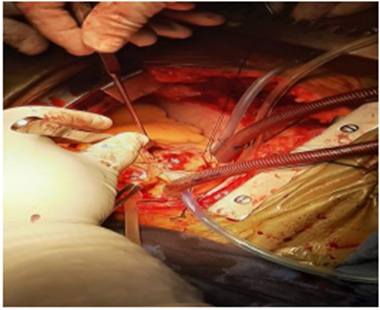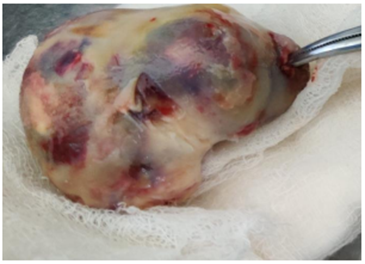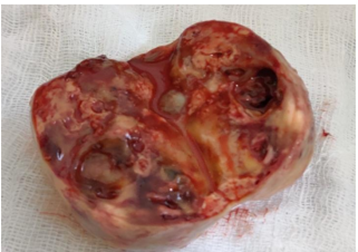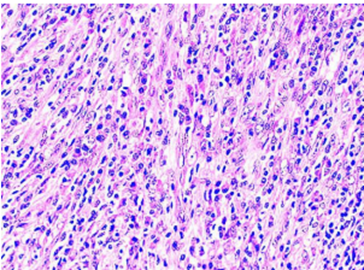AUCTORES
Globalize your Research
Case Report | DOI: https://doi.org/10.31579/2693-2156/051
Department of Anesthesiology, Zhongshan City People’s Hospital, Zhongshan, China.
*Corresponding Author: Xiaozu Liao, Binfei Li, Department of Anesthesiology, Zhongshan City People’s Hospital, Zhongshan, China.
Citation: Kannan G, RM Krishnan, M Rajan, S Kumar, K Balamurugan, Dinakaran Daniel (2023), A Rare Case of Inflammatory Myofibroblastic Tumor of Left Atrium, J Thoracic Disease and Cardiothoracic Surgery, 4(3); DOI:10.31579/2693-2156/051
Copyright: © 2023, Kannan G, RM Krishnan. This is an open access article distributed under the Creative Commons Attribution License, which
permits unrestricted use, distribution, and reproduction in any medium, provided the original work is properly cited.
Received: 28 March 2023 | Accepted: 07 April 2023 | Published: 17 April 2023
Keywords: inflammatory myofibroblastic tumor; cardiopulmonary bypass;anaplastic lymphoma kinase(alk);vimentin;hypothermic circulatory arrest
Cardiac inflammatory myofibroblastic tumor(IMT)is a rare entity and is associated with distinct clinical, pathological and molecular features. The clinical behaviour, natural history, biological potential, management of such tumors is unclear. We present herewith an adult male who presented with similar entity involving the left atrium. Diagnostic tools included echocardiography and immuno- histopathology studies. Surgical management included resection of tumor mass. The possibility of IMT should be kept in the differential diagnosis of cardiac tumors especially in children and young adults.
Primary cardiac tumors are exceedingly rare in children and young adults with a reported overall prevalence rate of 0.08%.Majority of such tumors are benign which includes rhabdomyoma, fibromyoma, myxoma or teratoma. However, recently Inflammatory myofibroblastic tumor involving cardiac structures has emerged as a distinct clinical entity with characteristic clinical, pathological and molecular features such as predilection for visceral soft tissues with a tendency for local recurrence, fasciitis like compact spindle cell and hypocellular fibrous pattern and chromosomal translocation leading to activation of ALK tyrosine kinase in almost 50% of cases. We are reporting an adult male who presented with a mass in left atrium, who underwent surgical intervention. Due to its rarity, behaviour, management and prognosis of cardiac IMT is unclear.
A 46 year old gentleman was referred to us for evaluation of a left atrial mass diagnosed incidentally at referring hospital after excision biopsy of a gum lesion.
The patient had grade II dyspnoea. The laboratory tests revealed elevated liver enzymes. Two dimensional echocardiography showed presence of mass lesion in the left atrium. In view of possibility of tumor embolisation and unknown nature of cardiac mass, surgical intervention was undertaken under standard cardiopulmonary bypass. Intra-operative transesophageal echocardiography confirmed the location of tumor within left atrium. Cannulation of ascending aorta and bicaval cannulation was done. Under systemic hypothermia (28 degree centigrade),aortic cross- clamping and cardioplegic arrest, right atriotomy was performed. Inter atrial septum was incised circumferentially in the region of fossa ovalis and tumor was removed from left atrium in toto. Pericardial patch closure of inter atrial defect done. Right atrium closed. Patient rewarmed and was weaned of cardiopulmonary bypass. Surgical oncologist opinion was obtained for gingival soft tissue lesion and they performed excision of the lesion simultaneously during excision of left atrial mass.

Figure 1: Intra operative photograph of the left atrial mass

Figure 2: Gross specimen of the tumor with stalk
Histopathology of the tumor revealed presence of myofibroblastic proliferation with infiltration of variable number of lymphocytes, plasma cells and macrophages. Myofibroblasts are spindle shaped with moderate cytoplasm and elongated vesicular nuclei. Focal necrosis, haemorrhage with few hemosiderin laden macrophages are seen. The immuno stain marker profile showed productivity for vimentin, smooth muscle actin iso forms, but negativity for ALK protein. The constellation of findings described above established the diagnosis of IMT. Histopathology of gingival growth turned out to be pyogenic granuloma.

Figure 3: Gross specimen of the tumor showing focal areas of Necrosis and hemorrhage

Figure 4: Cellular pattern with spindled myofibroblasts fibroblasts in more compact stroma, arranged as islands surrounded by fibromyxoid stroma

Figure 5: Immuno-Histochemistry of The Specimen Showing Productivity for Vimentin and Smooth Muscle Actin
Usually IMTs involves lungs, liver, stomach, lymph nodes, retroperitoneal tissues and spleen. World Health Organisation’s classification has included IMTs as tumor of intermediate biological potential due to tendency for local recurrence and small risk of metastasis. Cardiac involvement is very rare. In available papers, involved cardiac structures were right atrium, right ventricle, tricuspid valve and inter ventricular septum. Involvement of left atrium has not been reported.
There are no specific signs or symptoms related to cardiac IMTs, as these are related to the location within the heart. However, these tumors are thought to elaborate cytokines that may produce constitutional symptoms and signs such asfever, anorexia, anaemia, hyper gamma. globulinemia, leukocytoclastic, asculiitis, polyarthritis, thrombocytosis and mildly elevated liver enzymes. The pathogenesis of IMT is thought to be an exaggerated immunological response by proliferated spindle cells and primary myofibroblasts to injury, inflammation and infection. In addition, the IMT is characterized by expression of vimentin, smooth muscle actin and cytokeratins, corresponding to those of myofibroblasts along with other inflammatory markers. Several authors have demonstrated production of IL 6 mRNA and protein by tumor cells, supporting a possible analogous mechanism in IMT. Interleukin production is thought to be an additional underlying cause of systemic symptoms and complications which may return to normal post operatively. Similarly, IL 6 and cytokines may be inflammatory markers of tumor recurrence during post operative follow up.
Surgical excision of tumor has been the mainstay of management, though radiotherapy, immunosuppressants and chemotherapy have been tried as an adjunct to surgery without additional benefit.
Cardiac IMTs are potential benign lesions with favourable prognosis and should be considered in diagnosis of cardiac tumors in children and young adults. Surgical management is currently the preferred management approach. Although recurrence or metastasis of cardiac IMTs has not been reported yet, the follow up of such patients should be aimed to monitor recurrence which may be heralded by return of clinical or laboratory abnormalities. Therefore, a physical examination, echocardiography and blood tests for inflammatory markers, platelet counts and IL 6 levels are mandatory at regular intervals during long term follow up. In addition, patients should be informed about variable behaviour and nature of the entity.